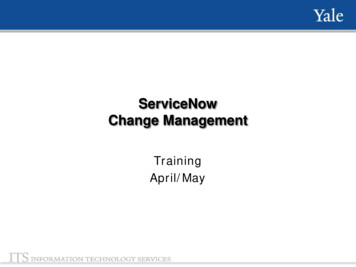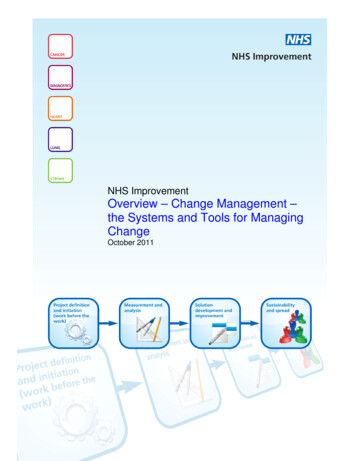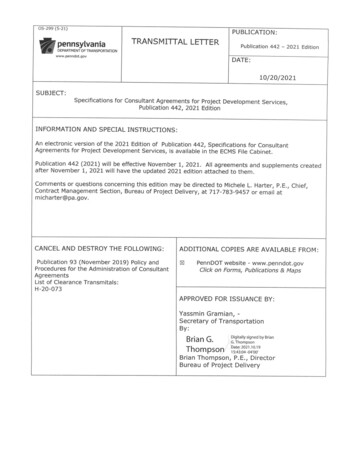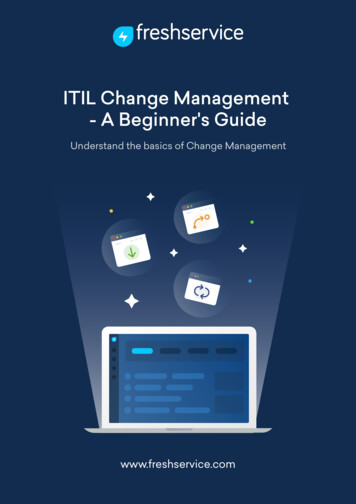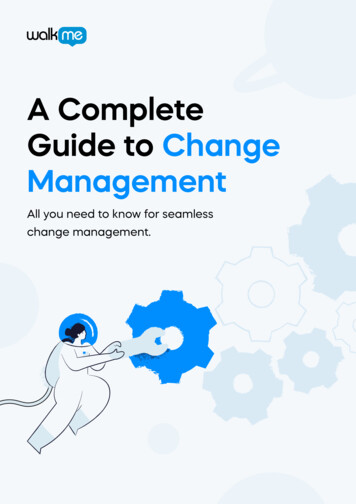
Transcription
A CompleteGuide to ChangeManagementAll you need to know for seamlesschange management.
What is Change Management?Change management is the catch-all term for all the ways of preparing,supporting, and helping teams, individuals, and organizations undergochange.There are various causes for change, including: Evolution of technologyInternal process reviewsCrisis responseCustomer demand changes Competitive pressure Acquisitions and mergers Organizational restructuringSuch change might include redefining and/or redirecting budgets,resources, business processes, and operations in general. Changemanagement usually only refers to how personnel and teams areaffected by changes within the organization, whereas organizationalchange management (OCM), is about the total organizational change ofan entire company or business.The Association of Change Management Professionals (ACMP) defineschange management as:The practice of applyinga structured approach totransition an organization froma current state to a future stateto achieve expected benefits.A Complete Guide to Change Management2
Change management provides this direction with specific actionsthat can be taken to influence and support people in theirindividual transitions.There are three forms of change management:123Individual ChangeManagementOrganizational/InitiativeChange ManagementEnterprise ChangeManagementChange Management StrategyChange for the sake of change is hardly beneficial to a business, as itputs strain on employees and resources. But with a clear strategy andpurpose, an organization can make changes that directly benefit thebusiness. Knowing the plan, the characteristics of the change, its risks,and potential resistance makes for a smooth transition for changepractitioners, project teams, and partners.Keep in mind, all change is different and requiresa unique approach. Consider these changes: Relocating office spacesChanges in senior leadershipAcquiring a companyImplementing a new web-based form and processA Complete Guide to Change Management3
Creating a Change Management StrategyUse the following steps to guide you through the development of yourstrategy for change management.1. Identify Change CharacteristicsStart with a list of questions as you prepare a strategy formanaging change: What is the scope of the change? Who is being impacted (employees, customers, others)? How many people will be affected? How are people being impacted? Are people experiencing the change differently? What is being changed (systems, processes, roles)? What is the timeframe for the change?Having answered these questions, you’ll have a better direction andgreater intent behind your plan for change.2. Assess the OrganizationUse the following steps to guide you through the development of yourstrategy for change management.Some questions to ask at this phase include:What is the perceived need for this changeamong employees and managers?How have previous changes been managed?How many changes are currently takingplace (internally, or in the world)?Is there a shared company vision?A Complete Guide to Change Management4
3. Create the Change Management StrategySuccessful strategies make sure to include:Team StructureThis determines who will be doing the change management work andoutlines the relationship between the project team and the changemanagement team.This often involves placing a change manager in a project team, havinga centralized change management team to support the project team,and/or assigning change management to a project team member.Be sure to get specific about responsibilities and resources!Sponsor CoalitionThe sponsor coalition refers to the leaders, managers, and stakeholderswho need to be actively involved in leading the change. The mainsponsor is of course the individual who authorizes and promotesthe change.This figure will be largelyresponsible for building acoalition of sponsors throughoutthe organization.Choose leaders from groupsimpacted by the change. Eachmember of the coalition has theduty of garnering support andcommunicating the changewith their respective audience.A Complete Guide to Change Management5
Anticipate Resistance & Special TacticsWhen change occurs, there’s usually resistance. Often, this resistancecould have been anticipated and prepared for accordingly.When planning change, try to predict potential resistance andreactions by asking these questions:Are certain divisions or regions impacted differently than others?Were some groups sharing a different solution to the problem?Are certain groups greatly invested in how things are currently done?Take note of the particular resistance points you might encounter andplan special tactics to deal with them before the process begins.Risk AssessmentPeople are always going to be a potentially sizable risk, especially ifthey’re not managed and supported properly throughout the transition.Certainly, farther-reaching projects have a higher risk level. A criticalcomponent of the strategy is documenting the overall risk and specificrisk factors.Consider the change characteristics (small/incremental or large/disruptive) and organizational attributes (ready for change vs. resistantto change) in order to conduct a thorough risk assessment.A Complete Guide to Change Management6
Change Management FailureThere are many reasons why change initiatives can fail. Employeesmay be frustrated with the changes or the management of the change.Customers might not receive the changes well, or there might beconfusion around the change. This list will identifies more reasons whychange initiatives fail and help you ensure that yours will succeed.Reasons why change initiatives fail: There’s no explanation as to why the change is taking place The change is too big for the time frame Bottom-up support for change is lacking Change management support is weak The initiative lacks inspiring leadership Leadership ignores change resistance as a source for learning Management pushes too hard and doesn’t recognizeorganizational exhaustion The plan is rigid and doesn’t adjust to upcoming developments The organization’s culture is not taken into considerationStudy this list and be prepared to revisitit throughout your change initiative soyou can prevent failure, as well as bettersupport your organization and yourpeople through times of change.A Complete Guide to Change Management7
Change Management ModelsWhen it comes to the how of change management, there are a varietyof models. These provide direction and often simplify the endeavor. Hereare 7 of the most widely used models.Lewin’s Change ManagementUsing the analogy of melting and refreezing an ice cube, Kurt Lewindeveloped the idea that change occurs in 3 simple stages:Unfreeze, Change, Refreeze.ADKARThe ADKAR model focuses on the people, starting with individual change.ADKAR is an acronym for:Awareness – of the need for changeDesire – to participate in and support changeKnowledge – of how to changeAbility – to implement changeReinforcement – to sustain changeA Complete Guide to Change Management8
Kotter’s 8-Step Change ModelAfter a survey, John Kotter developed this model that looks more atthose involved in the change rather than the changes themselves.The 8 steps are: Create a sense of urgency. Build a coalition. Form a strategic vision. Get everyone’s buy-in. Remove barriers to enable action. Generate short-term wins. Sustain acceleration. Institute change.Kubler-Ross Change CurveMore well-known as the 5 stages of grief, this method is considered areliable model for change. The idea is that organizations can betterprepare for change by anticipating personnel reactions.The 5 stages are: Denial Depression Anger Acceptance BargainingA Complete Guide to Change Management9
McKinsey 7SCreated at the McKinsey firm by Thomas J. Peters and Robert H.Waterman, this method zeroes in on the 7 fundamental elements ofevery organization, starting with the hard elements and transitioning intothe soft elements:StrategyStructureShared ValuesSystemStyleStaffSkillsPDCAAlso referred to as the Deming wheel or control cycle, this model wasfounded in the 1950s. The acronym stands for: Plan-Do-Check-Act/Adjust. It’s a cyclical process for continuous change and improvement.It follows these steps: Make a plan. Test the plan. Implement the plan. Evaluate the plan and makenecessary changes.A Complete Guide to Change Management10
Bridges Transition ModelAnother people-centric model, the Bridges Transition is about thetransition to the change and people’s experience, not the change itself. Itemphasizes how employees let go of the old and adopt the new.There are 3 stages: Ending/losing/letting go Neutral zone New beginningsChange Management PlanWith a change management strategy in place, a proper plan can nowbe constructed. Creating a plan for change takes into account all ofthe details such as budget, time frame, scope, communication,and resources.The following steps will help you prepare your plan for change.Prepare the Organization for ChangeAn organization must be ready for changes, both culturally andlogistically. Start with the cultural prep then dive into the logistics sideof things.During this phase, change managers focus on helping employeesunderstand the need for change. They need to raise awareness aboutexisting issues and challenges the organization is facing that necessitatechange. In essence, you want to get the buy-in of employees as it willreduce friction and resistance along the way.A Complete Guide to Change Management11
Craft a Vision for ChangeThis is where the plan is pieced together. The change manager developsa detailed and realistic plan for bringing about the change(s). A plancan only be created after the company is ready to embrace change.As mentioned, the plan should include: Strategic goals Key Performance Indicators (KPIs) Project stakeholders and teams The project scopeThe plan should also include potential roadblocks that could arise andhow they will be handled.Implement the ChangesNow it’s time to get started. Whether the change is structural, strategic,systems or process-related, connected to employee behavior, oranything else—follow the outlined plan, step by step. At this point,change managers must empower their people to take the requiredsteps to achieve the goals of the change initiative. As the companyimplements changes, managers must be prepared for obstacles—identifying, preventing, removing, and mitigating them as they go.Regular and repeated communication of the plan and theorganizational vision throughout the process is crucial. Team memberswill need frequent reminders as to why the change is being undertaken.A Complete Guide to Change Management12
Embed Changes Within Company Culture & PracticesEven once the changes are successfully made, the journey is not over.Change managers need to make sure there are no reversionsto previous states or the status quo. This is particularly relevant tochanges in processes, workflows, culture, and strategies. You don’twant employees to fall back into the old way of doing things.That’s why it’s so important tomake sure changes are deeplyembedded in company cultureand practices. Consider neworganizational structures, controls,and rewards to prevent reversions.Review Progress & Analyze ResultsWhen it’s all done, how do you know it was successful? The completionof changes doesn’t necessarily indicate success. By conducting reviewsand analyses during and after the change is made, business leaderscan determine if they were truly successful, or if they failed or had amixed result. There are also valuable lessons and insights to be learnedthat can be helpful in future initiatives.A Complete Guide to Change Management13
Change Management PrinciplesThere are some principles you should adhere to when implementingchange. Keep these in mind regardless of the size of changeyou’re undergoing: Understand change. We change for a reason. Plan change. Purpose and direction are necessary. Implement change. Change must also occur on the individual level. Communicate change. Be open and transparent.In addition to these guiding principles, here’s a list of best practices forchange management: Mobilize active and visible executive sponsorship. Follow a structured change management plan. Engage with front-line employees. Have dedicated change management resources. Interact with project management. Engage with and support middle managers.A Complete Guide to Change Management14
Change Management CertificationYou can become a Certified Change Management Professional (CCMP).The CCMP course is based on the Association of Change ManagementProfessionals’ Standard for Change Management, and it’s globallyrecognized.To become a CCMP, you must apply for the course, get the handbook,and successfully complete the exam, which consists of 150multiple questions.Who Should Certify in Change Management?The CCMP role is good for anyone in change management wanting toapply the best practices. This could include: Organizational change managers Change leaders Project management leaders HR professionals Training and communication professionals Knowledge management specialistsA Complete Guide to Change Management15
What is the Value of the CCMP Certification?This credential will help in your job search whether entering the jobmarket or trying to raise your profile as a qualified professional in theindustry. It will differentiate you from other candidates, as well as provideother benefits such as: Showcasing knowledge and experience Aligning you with an international standard Enhancing career prospects Demonstrating commitment to ongoing professional development*The course costs 595USD for members of the ACMP, and 745USDfor non-members.A Complete Guide to Change Management16
The Role of a Change ManagerFirst define the role of a change manager: a person who plans, develops,delivers, and tracks change management deliverables. This includescommunications, training, stakeholder engagement, change impactassessment, organizational readiness analysis, coaching, resistancemanagement, and change reinforcement.The role of a change manager is to come up with a plan for, carryout, and manage change within an organization. They help personneltransition from their current state to a future state.The change manager—guided by the change management strategy—executes the complex plan for change in a way that makes it easier forimpacted users and stakeholders. Change managers work with projectteams and business partners who are eager for change. They mustbe able to build cross-functional relationships, think critically, and takeinitiative to drive results.Some specific responsibilities of a change manager are: Managing stakeholder relationships Conducting effective change impact assessments Defining and measuring success metrics and monitoringchange progress Identifying and implementing improvements to the changemanagement strategy Creating executive presentationsA Complete Guide to Change Management17
Change Management ToolsSome change management tools that can help with thetransition include: Flowcharts/process Maps Culture mapping ADKAR analysis Force field analysis Kotter’s 8-step change model Lewin’s change model Gantt chartsOrganizationalChange ManagementOrganizational change management is when companies make majorchanges, whether it be the culture, technologies, or infrastructure.It’s how organizations leverage change to bring about a successfulresolution and enhancements to the business.Typically, there are 3 phases to organizational change management:1PreperationA Complete Guide to Change Management23ImplementationFollow-Through18
What causes organizational change? There are a variety of factorsthat necessitate change. Some of the most common ones faced bymanagers include: New leadership at the helm of the companyor within certain departments Alterations in team structure Implementation of new technology The adoption of new business modelsThere are both adaptive changes and transformational changes.The former entails small, incremental changes that organizationsadopt to meet needs that evolve over time. Such changes are minormodifications or adjustments by managers. Examples of this type ofchange might include upgrades to operating systems, or using newweb-based forms.Transformational changes are large-scale. They might be majorchanges such as a shifting mission statement or strategy, or companystructural reformations. Obviously, these big alterations take time andresources to properly carry out. Transformational changes are usuallymade in response to external factors, like disruptive competitors, supplychain issues, or consumer demands. An example of this type could bethe adoption of a CRM.Change is necessary for growth and success. Change managementhelps employees understand, adapt, and enact the changes. Which iswhy an effective change management strategy is the ultimate gatewayto building a culture of streamlined collaboration and productivity.A Complete Guide to Change Management19
About WalkMeWalkMe’s cloud-based Digital Adoption Platform enables organizations to measure, drive, and act toultimately accelerate their digital transformations and better realize the value of their software investments.Our code-free platform leverages our proprietary technology to provide visibility to an organization’s CIO andbusiness leaders, while improving user experience, productivity and efficiency for employees and customers.For more information, please visit our website at: www.walkme.comWalkMe is successfully deployed on:
This determines who will be doing the change management work and outlines the relationship between the project team and the change management team. This often involves placing a change manager in a project team, having a centralized change management team to support the project team, and/or assigning change management to a project team member.
![Change Management Process For [Project Name] - West Virginia](/img/32/change-20management-20process-2003-2022-202012.jpg)
